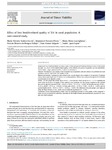Mostrar o rexistro simple do ítem
Effect of foot health-related quality of life in rural population: A case-control study
| dc.contributor.author | López-López, Daniel | |
| dc.contributor.author | Andreo García, María Victoria | |
| dc.contributor.author | Navarro Flores, Emmanuel | |
| dc.contributor.author | Losa Iglesias, Marta Elena | |
| dc.contributor.author | Becerro-de-Bengoa-Vallejo, Ricardo | |
| dc.contributor.author | Gómez Salgado, Juan | |
| dc.date.accessioned | 2023-07-21T10:43:37Z | |
| dc.date.available | 2023-07-21T10:43:37Z | |
| dc.date.issued | 2023-08 | |
| dc.identifier.citation | María Victoria Andreo-García et al., Journal of Tissue Viability, https://doi.org/10.1016/j.jtv.2023.04.007 | es_ES |
| dc.identifier.uri | http://hdl.handle.net/2183/33374 | |
| dc.description.abstract | [Abstract] Background: Foot health problems can affect quality of life and general health producing a source of discomfort and pain. Low levels of foot health-related quality of life (HRQoL) are present in patients with foot disabilities, such as hallux valgus, plantar fasciitis, or minor toe deformities. Objective: The objective was to analyze the foot health status in patients with and without foot problems in a rural population and its relationship with quality of life. Material and methods: A prospective case-control study was developed with a sample of 152 patients, 76 subjects with podiatric pathologies and 76 without, in a rural population. HRQoL was measured through the SF-36 Health Questionnaire in the Spanish version. Results: The case group had a mean age of 49.18 ± 14.96 and the control group 44.16 ± 11.79. Regarding the score of the lowest levels of quality of life related to foot problems, the case group compared to the controls showed: for physical function (79.86 ± 26.38 vs. 92.63 ± 11 0.17, p < 0.001); for the physical role (73.68 ± 41.00 vs. 88.48 ± 27.51, p < 0.0022); for body pain (45.81 ± 27.18 vs. 73.68 ± 41.00, p < 0.035); and for general health (60.36 ± 30.58 vs. 68.71 ± 18.52, p < 0.047). The differences between groups were analyzed using the Mann-Whitney U test, which showed statistical significance (P < 0.05). Conclusions: In the rural population, people with foot pathologies present a worse quality of life compared to those who do not present foot pathology, especially for the health domains: physical function, physical role, body pain and health general. | es_ES |
| dc.language.iso | eng | es_ES |
| dc.publisher | Elsevier | es_ES |
| dc.relation.uri | https://doi.org/10.1016/j.jtv.2023.04.007 | es_ES |
| dc.rights | Atribución-NoComercial-SinDerivadas 3.0 España | es_ES |
| dc.rights.uri | http://creativecommons.org/licenses/by-nc-nd/3.0/es/ | * |
| dc.subject | Health-related quality of life | es_ES |
| dc.subject | Calidad de vida referida a la salud | es_ES |
| dc.subject | Foot disabilities | es_ES |
| dc.subject | Discapacidad en el pie | es_ES |
| dc.subject | Encuesta | es_ES |
| dc.subject | Rural-urban disparities | es_ES |
| dc.subject | Disparidad entre lo urbano y lo rural | es_ES |
| dc.subject | Questionnaire | es_ES |
| dc.title | Effect of foot health-related quality of life in rural population: A case-control study | es_ES |
| dc.type | journal article | es_ES |
| dc.rights.accessRights | open access | es_ES |
| UDC.journalTitle | Journal of Tissue Viability | es_ES |
| UDC.volume | 32 | es_ES |
| UDC.issue | 3 | es_ES |
| UDC.startPage | 389 | es_ES |
| UDC.endPage | 394 | es_ES |
| UDC.coleccion | Investigación | es_ES |
| UDC.departamento | Ciencias da Saúde | es_ES |
| UDC.grupoInv | Grupo de Investigación Saúde e Podoloxía (GISAP) | es_ES |
Ficheiros no ítem
Este ítem aparece na(s) seguinte(s) colección(s)
-
Investigación (FEP) [511]






